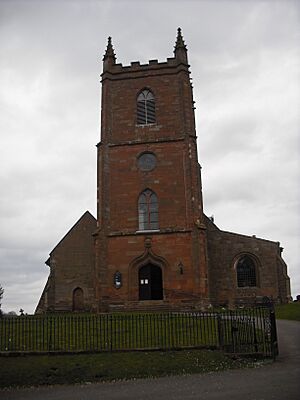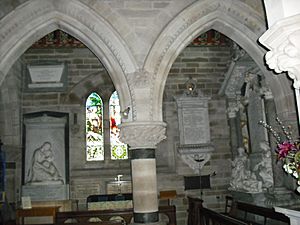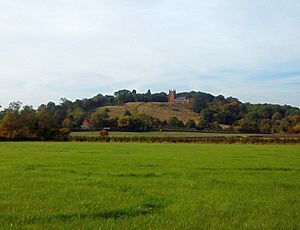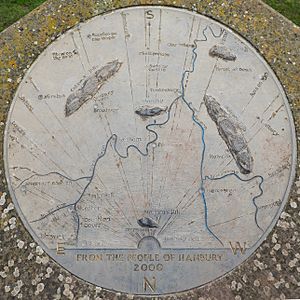St Mary the Virgin, Hanbury facts for kids
Quick facts for kids St Mary the Virgin, Hanbury |
|
|---|---|
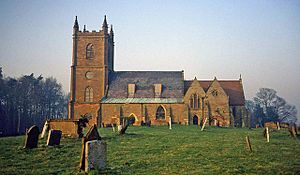
Church of St Mary the Virgin, Hanbury
|
|
| Lua error in Module:Location_map at line 420: attempt to index field 'wikibase' (a nil value). | |
| Location | Hanbury, Worcestershire |
| Country | England |
| Denomination | Anglican |
| Website | http://www.hanburychurch.org/ |
| History | |
| Status | Parish church |
| Founded | c. 1210 |
| Dedication | Saint Mary the Virgin |
| Architecture | |
| Functional status | Active |
| Administration | |
| Diocese | Worcester |
| Province | Canterbury |
St Mary the Virgin Church is an Anglican church in the village of Hanbury, Worcestershire, England. It's a special place of worship that has been around for a very long time. The oldest parts of the church were built around the year 1210. It is so important that it's officially recognized as a Grade I listed building, which means it's a historic and protected site. For many years, this church was the main place of worship for the Vernon family, who lived nearby at Hanbury Hall.
Contents
Exploring the Church's Outside
The church building shows off two main styles: Early English and Georgian. It's built from sandstone rocks and smooth stone blocks. The roofs are made of slate and flat tiles.
The West Tower
The tower at the west end of the church was rebuilt in 1793. It has three main sections, with decorative stone bands between them. The very bottom part of the tower acts as a porch and the main entrance. It has a fancy arched doorway. Higher up, there are round windows and pointed windows. The top section, called the belfry, has windows where the bells are. Above these, there's a decorated stone band and a wall with a jagged top, like a castle. This top part was fixed up in the mid-1900s.
Other Outside Features
You'll see some pointed windows on the church walls. Some of these still have stone from the 1300s. There are also some square-shaped windows. The south side of the church has a roof that slopes down on one side. It also has strong supports called buttresses.
The Chancel and Transepts
The chancel, which is the part of the church near the altar, was built around 1860. It has three sections with buttresses at the ends. The large east window has three lights (sections) and a decorative stone arch above it. There are also pointed windows on the north-east and south-east sides. The north transept (a part of the church that sticks out like an arm) has four tall, narrow windows and a round rose window above them. A smaller room called the vestry sticks out from the east side of the north transept.
The south transept also has a wing that runs parallel to the east.
Churchyard and Graves
The churchyard is the area around the church. Here, you can find the grave of Emma Vernon (1754–1818), who inherited the Hanbury Estate. There is also a war grave for a soldier from the Royal Corps of Signals who died in World War II.
The vestry and transept areas include the Vernon Chapel. This chapel has a central pointed doorway with decorative carvings. Above the doorway is a three-light window. Next to it, there's a special monument for Thomas Bowater Vernon (who passed away in 1859). Above this monument, you'll see another rose window.
Inside the Church
The church has a main area called the nave, with aisles on the north and south sides. It also has a chancel, north and south transepts, a north vestry, and a south chapel. Inside the porch, there's a wooden staircase that leads up to the belfry and a gallery where musicians might have played.
Arches and Columns
The south side of the church has arches from around 1210. These arches are supported by round columns. The north side has arches supported by eight-sided columns. The large arch leading to the tower is blocked off, but you can still see its shape. The arch leading to the chancel is pointed and has decorative carvings.
Roofs and Special Features
Many parts of the church have "wagon roofs," which look like the inside of a covered wagon. In the nave and aisles, these roofs are plastered. In the chancel and transepts, they are beautifully painted. The chancel also has special features like a piscina (a basin for washing sacred vessels), sedilia (seats for clergy), and an aumbry (a cupboard for sacred items).
Memorials and Stained Glass
The church has many memorials to important people. In the Vernon Chapel, there's a large monument for Thomas Vernon (who died in 1721). It shows a statue of him resting, with figures representing Justice and Learning beside him. There's also a statue of Bowater Vernon (who died in 1835) and a large marble carving for Thomas Taylor Vernon (who died in 1837). Another memorial from the late 1600s remembers Richard Vernon (who died in 1678).
In the chancel, there's a wall memorial for Richard Vernon (who died in 1627), showing two kneeling figures. In the nave, there's a large carving for Thomas Vernon (who died in 1771). The east window of the Vernon Chapel and the north transept have beautiful stained glass from the 1800s.
Church Bells
The church has a set of eight bells that date back to 1678. They are still in excellent condition and are used regularly.
Church History
The church was restored and improved around 1860 by a famous architect named George Edmund Street.
Bowater Vernon gave the church a special silver-gilt Communion service (cups and plates used in church services). This beautiful set was made by a French silversmith named Simon Pantin.
How the Church is Run and What it Does
The church is part of the Anglican Diocese of Worcester, which is then part of the larger Province of Canterbury.
People who enjoy bell ringing often come to the church. The Worcestershire & Districts Change Ringing Association helps organize these ringing sessions.
St Mary the Virgin Church has also been used as a filming location! It played the role of St Stephen's Church in the fictional village of Ambridge for the popular BBC Radio 4 series The Archers. Several recordings for the show took place here, including the wedding of characters Phil and Grace Archer.


